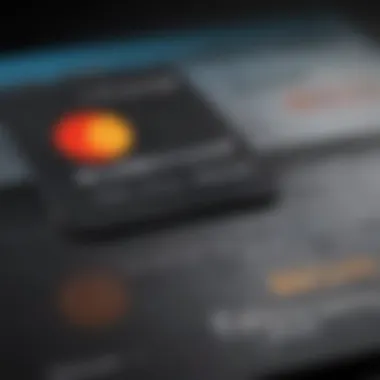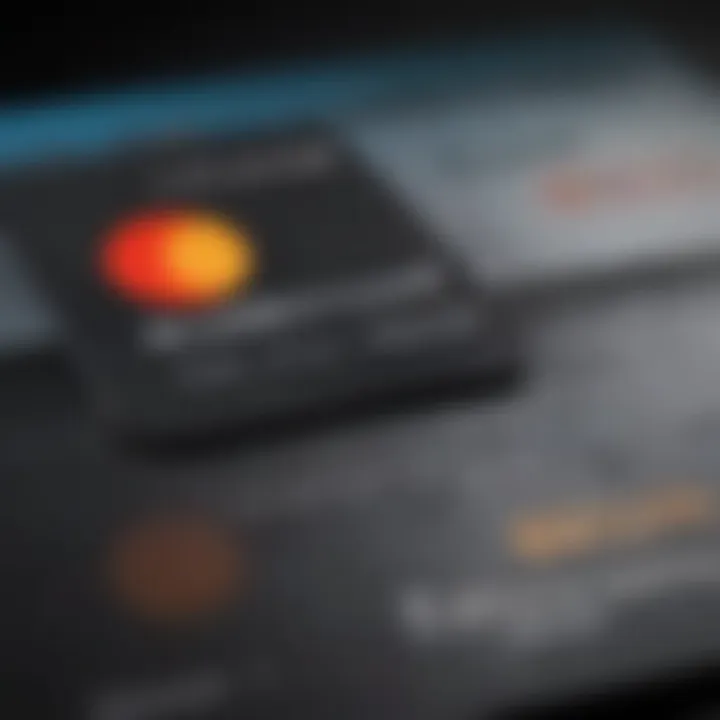Exploring Banks That Offer Mastercard Products


Intro
Choosing the right financial partner can lead to profound implications in terms of fees, services, and benefits that you might not have considered. Having a strong grasp on what banks provide these offerings, along with the pros and cons of each, can steer you toward making informed and beneficial decisions.
Overview of Financial Products
Definition and Significance
Mastercard is a widely recognized brand in the world of financial services. It serves as a payment network that facilitates electronic transactions between consumers and merchants. By issuing credit, debit, and prepaid cards under the Mastercard label, banks can provide customers with a world of convenience when making purchases.
The significance of Mastercard goes beyond just buying power; it shapes how individuals manage their finances. With robust security features, rewards programs, and additional services (like travel insurance), Mastercard cards can enhance consumer experiences in various aspects.
Types of Financial Products Available
When it comes to Mastercard offerings, banks typically provide several types of products. Here’s a quick rundown:
- Credit Cards: These allow users to borrow money to make purchases, with the expectation of paying it back later, often at a cost.
- Debit Cards: Linked to a checking account, debit cards let users spend money they already have.
- Prepaid Cards: These are pre-loaded with funds, providing a convenient way to manage spending without the risks of a traditional credit card.
Each of these types comes with unique attributes, catering to different needs and preferences.
Key Attributes
Interest Rates and Returns
Understanding the interest rates associated with Mastercard products can also impact your decision. Credit cards have varying APR (Annual Percentage Rate), which is essential for users who may carry a balance month-to-month. Lower rates can save you money in the long run, making it crucial to shop around.
Additionally, many banks offer rewards programs tied to Mastercard products, providing points, cash back, or travel benefits for responsible spending. Evaluating these returns can help you leverage the features of your card effectively.
Risk Factors Associated with Each Product
Just like every silver lining has a cloud, Mastercard products come with their own set of risks:
- Debt Accumulation: Using credit cards irresponsibly can lead to high levels of debt.
- Fraudulent Charges: Even with security features, fraud can occur.
- Fees: Some cards carry annual fees, late fees, or foreign transaction fees that might not be apparent at first glance.
It’s imperative to read the fine print and fully understand what you're signing up for before proceeding with any financial product.
By carefully evaluating the banks that offer Mastercard products and understanding the benefits and drawbacks involved, you empower yourself to choose the card that best suits your financial needs.
As we move forth in this article, we will delve deeper into the various banks that issue Mastercard and explore how they stack up against each other based on a variety of factors.
Foreword to Mastercard
Mastercard stands as one of the giants within the realm of digital payments, shaping how transactions flow across the globe. The significance of this financial service cannot be overstated as it not only provides convenience but also plays a pivotal role in fostering economic activity. When we discuss Mastercard in this article, we delve into aspects such as accessibility, security features, and the overarching benefits linked to it, which are pertinent for both everyday consumers and savvy investors alike.
Mastercard has continuously evolved since its inception, adapting to the dynamic landscape of financial interactions. Its innovations and commitments to improving payment systems have not only benefited consumers but have also transformed how businesses face and tackle payment challenges. Whether through credit cards, debit cards, or prepaid options, the framework within which Mastercard operates encourages financial inclusion and accessibility.
When considering a bank to partner with for Mastercard offerings, one must appreciate the various dimensions involved. Factors like available products, fees, customer support, and reward programs come into play, each influencing the decision-making process for individuals and families as they seek financial partners that align with their priorities.
Through understanding Mastercard, its history, and its role in our financial lives, readers can make more informed choices about not only which bank to choose but also how to maximize the benefits of their Mastercard products. This foundational knowledge acts as a guide as we journey into the specifics of Mastercard’s products, the banks that offer them, and the unique criteria for selecting a suitable financial institution.
History of Mastercard
Mastercard’s journey is a fascinating tale that begins in the 1960s, a time when the financial world was quite different. Established originally as the Interbank Card Association, it took on the name Mastercard in 1979. The shift to this name signified not just a commitment to innovation, but also a recognition that it was not merely a middleman in transactions but a key player mobilizing change in how consumers approach payments.
The late 20th century brought on significant technological advancement, and Mastercard wasn’t left in the dust. From the introduction of smart cards in the 1990s to pushing for the adoption of chip technology, the brand paved the way for enhanced security and consumer confidence. When major crises like economic downturns and technological disruptions arose, Mastercard was often in the thick of pioneering solutions.
Role of Mastercard in the Financial Sector
Mastercard’s influence stretches far and wide within the financial sector. It acts as a bridge between consumers and merchants, simplifying transactions. As cash gradually phases out, Mastercard's role in empowering electronic payments becomes even more crucial.
"Mastercard not only simplifies how we pay but also reinvents our conditions of trade and commerce."
Its systems support billions of transactions globally every year. But beyond just being a payment facilitator, Mastercard is also about empowering users through initiatives in financial education and literacy. Such efforts attest to its dedication to fostering an ecosystem where consumers are informed, secure, and equipped to make sound financial decisions.
Furthermore, the company invests substantially in cybersecurity. This commitment not only enhances consumer protection but also builds trust in digital transactions. The importance of Mastercard in the financial sector thus manifests not just in its technological advancements but also in its ability to respond to and anticipate the financial needs of an evolving global landscape.
How Mastercard Works
Understanding how Mastercard operates is essential for anyone looking to navigate the world of electronic payments. This section breaks down crucial elements of Mastercard's functioning and highlights benefits as well as considerations for users.


Payment Processing Mechanism
The payment processing mechanism of Mastercard is a multi-step process that ensures that transactions are completed swiftly and securely. Here's a breakdown of how this mechanism operates:
- Initiating a Transaction: When a cardholder makes a purchase using their Mastercard, the point-of-sale terminal sends a request to the merchant's bank.
- Authorization Request: The merchant's bank then forwards this request to Mastercard's network. The request contains critical information such as the card number, transaction amount, and merchant details.
- Verification: Mastercard checks whether the account has sufficient funds or credit. This verification process usually takes just a few seconds. If the transaction is approved, an authorization code is generated.
- Settlement: Following approval, the transaction amount is deducted from the cardholder's account and credited to the merchant. This process can happen in the blink of an eye but involves multiple financial institutions.
- Transaction Confirmation: Both the cardholder and the merchant receive confirmation of the successful transaction.
This intricate system allows for seamless exchanges of money across the globe. The speed and efficiency of this operation go a long way in enhancing user experience.
A well-functioning payment system is crucial; speed can mean the difference between a confirmed sale and a lost customer.
Security Features of Mastercard
Security is at the heart of Mastercard's operations. Dive into some of its security features that create a safer shopping environment:
- EMV Chip Technology: Most Mastercard products now come with an embedded chip. This chip generates a unique code for each transaction, rendering stolen card data useless.
- Mastercard Identity Check: This program utilizes biometric technology such as fingerprints and facial recognition for online transactions, adding an additional layer of security.
- Fraud Monitoring: Mastercard employs real-time monitoring systems that flag suspicious activities. If anything seems off, they quickly notify the cardholder to verify the transaction.
- Zero Liability Policy: With Mastercard, cardholders aren't responsible for unauthorized transactions as long as they report them in a timely manner.
These features solidify Mastercard's reputation as a safe choice for consumers. With the ever-evolving digital landscape, the commitment to security becomes increasingly vital, keeping fears of fraud at bay.
In summary, how Mastercard works is foundational for understanding its value. From speedy payment processing to robust security measures, users can feel confident in their choices, paving the way for informed banking decisions.
Types of Mastercard Products
When exploring Mastercard as a financial tool, it's essential to differentiate between the various types of products offered under this brand. Each product serves unique purposes and suits different needs, making understanding them a crucial part of navigating the banking landscape. The distinction helps consumers not only to make informed decisions but also to align their financial habits with the right Mastercard solution. Here’s a deep dive:
Credit Cards
Credit cards backed by Mastercard provide users with a line of credit from which they can borrow money for purchases. This flexibility allows cardholders to manage their cash flow effectively, particularly for larger expenditures. Consumers often find themselves enjoying benefits like reward points or cash back deals on everyday spending. It’s a great way to put one’s expenses toward future savings or travel. Just be cautious—while credit cards can be beneficial for managing payments and earning rewards, they can also lead to high-interest debt if not used responsibly.
Key features often associated with Mastercard credit cards include:
- Interest-free periods: Many cards offer a grace period before charges accrue interest.
- Rewards programs: Users may earn points for travel, shopping, or dining.
- Purchase protections: Some cards provide features like extended warranties or theft protection for purchases.
Debit Cards
Conversely, a Mastercard debit card gives you direct access to your bank account. This means you can only spend what you already have, which helps many people avoid the pitfall of falling into debt. It’s a more straightforward approach to managing finances. Debit cards often come with fewer fees compared to credit cards, and they allow instant access to funds as well as easier tracking of spending habits.
Benefits of Mastercard debit cards include:
- Immediate transactions: Payments are debited directly from your bank account, aiding in better financial oversight.
- No debt risk: Since you’re using your own money, there's no worry about accumulating credit card debt.
- Ease of use at the ATM: These cards serve as a convenient way to withdraw cash from ATMs.
Prepaid Cards
Prepaid cards are another type of Mastercard product worth mentioning. Unlike credit and debit cards, prepaid cards require you to load money onto them before use. They act like cash in a card format. This can be an excellent option for individuals who want to control their spending, as the ability to only load a set amount of money onto the card can deter overspending.
Highlighting some advantages of prepaid cards:
- Budget management: They can help users manage their budgets, since only preloaded funds can be spent.
- Gift-giving options: They often make for great gifts where the givers can load specific amounts.
- Safety: Carrying a prepaid card is typically safer than carrying cash, and they can have protections against theft.
"Choosing the right Mastercard product hinges on understanding personal financial habits and needs."
In summary, whether you opt for a credit card, a debit card, or a prepaid card, each type of Mastercard product carries its own merits and drawbacks. Recognizing these differences is vital for selecting the one that best aligns with financial goals and spending behaviors.
Identifying Banks That Offer Mastercard
When it comes to choosing a bank that offers Mastercard products, there are numerous factors to consider. Knowing where to look for these banks helps consumers make informed decisions—it's like knowing the lay of the land before setting out on a journey. This section delves into the various types of banks that provide Mastercard options, enabling readers to weigh their choices effectively. Factors such as fee structures, customer support, and interest rates form the foundation upon which a suitable bank can be selected. By understanding the landscape, individuals can pinpoint banks that align with their financial goals and spending habits.
Large National Banks
In the realm of banking, large national banks are akin to the titans of the industry. They boast a wide array of Mastercard offerings backed by substantial resources. Think of institutions like Bank of America, Chase Bank, and Wells Fargo; these names ring bells across the country.
The reason many consumers flock to these banks can be attributed to their robust infrastructure. They tend to have a vast number of ATMs and branches, providing convenience. Moreover, they often have competitive reward programs tailored to attract a diverse customer base. For instance, a credit card from Chase can come packed with travel points, perfect for those who relish in wanderlust. Yet, it’s not all rosy; larger banks may also come with higher fees or stricter requirements when compared to smaller institutions.
Regional Banks
Regional banks, in contrast, often provide a more personalized touch while still offering a selection of Mastercard products. These institutions tend to cater to specific geographical areas. Names like Regions Bank or PNC Bank fall into this category, serving local communities.
With regional banks, clients often find that services feel less transactional and more relational. The staff may know you by name, and there’s an inherent understanding of local financial needs. They can sometimes offer lower fees or flexible financing options, which can be a boon for smaller ventures or individuals looking to build credit without the baggage of hefty charges. Yet, the range of credit products may not be as extensive as those from national banks.
Credit Unions


Lastly, credit unions often stand out as community-focused institutions that provide Mastercard products. They’re not-for-profit organizations, which generally translates to lower fees and better interest rates. For example, a member of a credit union like USAA or a local branch may find themselves offered attractive terms on a debit or credit card.
What makes credit unions appealing is their prioritization of member needs over profit. They can be particularly beneficial for consumers who appreciate a grassroots approach to banking. However, membership might be limited based on specific criteria such as geographic location or employment, which could be a hindrance for some.
It’s essential for individuals to thoroughly research their options, as the best choice can vary based on personal needs and financial lifestyles.
In sum, identifying banks that offer Mastercard products is a crucial step in achieving financial well-being. Starting with large national banks can provide a variety of options, while regional banks add a personal touch, and credit unions can offer compelling financial benefits. Regardless of the path taken, being informed can set the stage for the kind of banking experience that aligns with one’s financial aspirations.
Criteria for Selecting a Bank Offering Mastercard
Choosing a bank that offers Mastercard is akin to picking the right tool for a job. The right choice could mean the difference between seamless transactions and financial headaches. Understanding the criteria for selecting a bank is essential not only to maximize the benefits of your Mastercard but also to ensure a satisfactory banking experience. Several pivotal elements come into play when diving into this decision-making process.
Interest Rates and Fees
Interest rates and associated fees often take center stage when weighing banking options. On the surface, a bank may boast of appealing features, but a closer look at the fine print can reveal potential pitfalls. A typical credit card from a major bank might come with an interest rate of 15% to 25%. Keep in mind that the actual rate can vary significantly based on individual credit scores and other factors.
It’s crucial for potential cardholders to dig deeper into other fees as well. Consider the annual fees which can range from zero to upwards of $500, depending on the card's perks. For instance, Capital One offers cards with no annual fees while Wells Fargo might have premium options that require a considerable fee, but they come loaded with rewards. Look out for fees for cash advances, late payments, and foreign transactions, which can eat into your budget unexpectedly.
Reward Programs
Another aspect that sets banks apart is their reward programs. Some banks offer enticing cash back on certain categories like groceries or gas, while others might provide travel points that can be redeemed for flights or hotel stays.
For example, Chase Bank has a compelling rewards program that offers point multipliers for travel-related purchases. Meanwhile, Bank of America may offer excellent cash-back rewards for everyday spending. These reward programs can amplify the value of using your Mastercard, provided they align with your spending habits.
- Consider these factors:
- Types of rewards available (cash-saver, travel, etc.)
- Point redemption ease (how easily you can use your rewards)
- Expiration of points or cash back
Customer Service and Support
Amidst the technicalities of interest rates and rewards, one often overlooked but equally vital aspect is customer service. When situations arise—be it a lost card or suspicious transactions—having reliable support can alleviate a lot of stress. A bank with a reputation for efficient service can save you from long wait times and frustrating experiences.
Look for banks that provide 24/7 support, either through phone or chat services. Affirmative experiences from existing customers can also shed light on a bank’s service quality. Reading reviews on forums such as Reddit can reveal whether customers are left in a lurch or if they feel valued.
Additionally, consider the availability of digital tools—mobile apps that facilitate easy access to account information and offer alerts for transactions enhance overall satisfaction. In today’s digital world, having an accessible, user-friendly app can mean the world.
"Choosing a bank is not just about numbers; it’s about how they make you feel as a customer. The right bank feels like a safety net rather than a mere service provider."
In summary, potential Mastercard holders should view the selection process as a holistic assessment rather than merely a numerical analysis of fees and rates. By carefully analyzing interest rates, reward programs, and customer service quality, one can make an informed decision that aligns with their financial goals.
Notable Banks Offering Mastercard
The importance of recognizing notable banks that issue Mastercard goes beyond just finding a card. These banks represent a cross-section of the financial sector, delivering unique appeals and offerings, such as competitive rates, robust customer service, and specialized rewards programs. In a world where choices abound, discerning the right provider can lead to maximized benefits and minimized pitfalls associated with card use.
Here's a closer look at well-known banks that offer Mastercard products:
Bank of America
Bank of America features an extensive selection of Mastercard products, ranging from credit cards to debit and prepaid options. For customers, their offerings generally come with the added convenience of accessibility, as Bank of America has numerous branches and ATMs nationwide. The rewards programs associated with its cards are also compelling, often targeting travelers and everyday spenders alike. With features like no annual fees for certain cards, it encourages users to explore their options without the weight of upfront costs. Prospective applicants should keep an eye on interest rates, which can shift, and should be prepared for the necessity of good credit to secure the more rewarding cards.
Chase Bank
Chase Bank, part of the JPMorgan Chase & Co. family, is another heavyweight in the banking sector that provides a variety of Mastercard products. Known for offering a range of rewards cards, Chase emphasizes flexibility and travel perks, making their solutions particularly attractive for individuals who frequently travel or dine out. They also provide a digital platform that streamlines banking experiences. However, customers should pay close attention to the fine print regarding fees and interest rates. While there are lucrative benefits available, managing those effectively is essential for an overall positive experience.
Wells Fargo
Wells Fargo is well-regarded for its comprehensive banking services and its diverse array of Mastercard offerings. Their cards often come with built-in features aimed at enhancing security and financial management. Not only do they offer competitive rewards programs, but they also focus on customer service, with access to financial advisors for spending and savings guidance. They frequently run promotions that can be beneficial for new customers, but users must also be aware of the potential for fees. Evaluating various card options is wise to determine the best fit for individual needs.
Capital One
Capital One has carved a niche within the market by focusing heavily on online banking and a tech-forward approach. Their suite of Mastercard products includes options that appeal to both consumers and small business owners. Notably, Capital One cards often feature no foreign transaction fees, which is advantageous for travelers. Additionally, their rewards program is seen as quite lucrative in comparison to others. Despite these benefits, it is important to factor in that some cards might come with annual fees that could eat into the rewards accrued. Thus, review your spending habits before jumping on board.
Understanding the features and potential drawbacks of different Mastercard offerings from these banks can lead to more informed financial decisions.
Understanding Mastercard Benefits
When it comes to selecting financial products, understanding the benefits associated with Mastercard is crucial. It’s not just about convenience; it’s about making informed choices that align with your financial goals. Mastercard provides several advantages that can enhance your banking experience. This section will delve into various aspects that make these benefits significant for the discerning user.
Financial Flexibility


One of the key advantages of having a Mastercard is the financial flexibility it affords. With a Mastercard, cardholders often have access to higher spending limits, which can be particularly advantageous in emergencies. For instance, imagine you’re on a spontaneous trip, and an urgent expense arises. A Mastercard can provide the cushion needed to manage those unexpected costs without the immediate stress of cash flow concerns.
Moreover, the ability to manage payments over time adds to this flexibility. Cards can allow for balances to be carried month to month, giving users the ability to plan larger purchases without the financial strain of upfront payments. This can be particularly beneficial for those who require financial leeway in budgeting for their monthly expenses.
A few considerations to keep in mind regarding flexibility:
- Credit Limits: Higher limits can provide more purchasing power.
- Payment Options: Many Mastercard products come with varying payment structures, allowing for tailored options.
- Cash Advances: Access to funds within your credit limit when cash is needed urgently.
Global Acceptance
Another remarkable benefit is the global acceptance of Mastercard. This payment network has extensive coverage, making it a preferred choice for international travelers. It’s not uncommon to find that when a travel destination seems to be remote or off the beaten track, Mastercard is still welcomed. This can greatly eliminate the hassle of converting large sums of cash or carrying significant amounts of currency when abroad.
Consider the peace of mind that comes with knowing you can use your Mastercard without the fear of being caught short on funds. Additionally, when transactions happen in foreign currencies, Mastercard often provides competitive exchange rates. Here's why this is important:
- Widespread Acceptance: Accepted at millions of locations worldwide, from hotels to restaurants.
- Currency Conversion Fees: Usually lower than those from currency exchange services.
- Travel Rewards: Cards often offer rewards on international purchases, which can contribute to loyalty programs.
Access to Exclusive Offers
Cardholders often gain access to a range of exclusive offers and benefits. Many banks that issue Mastercard products have partnerships with various service providers, leading to exclusive discounts and promotions. Whether it’s special rates on travel bookings, dining experiences, or cashback on purchases, these perks add tangible value to being a Mastercard holder.
Moreover, special rewards programs can amplify the advantages of card use. You might find offers on lifestyle essentials or even luxury experiences designed specifically for Mastercard users. These exclusive offers can turn everyday expenses into opportunities for savings and enhanced experiences:
- Travel Deals: Discounts on flights, hotels, and rental cars.
- Shopping Rewards: Cash back or discounts on purchases from specific retailers.
- Luxury Access: Invitations to events or special promotions that non-cardholders might miss out on.
"With a Mastercard, the world opens up, it's not just about payments; it's about experiences."
In summary, the benefits associated with Mastercard products transcend merely having a card in your wallet. They provide significant financial flexibility, global acceptance, and access to exclusive offers that can greatly enhance your overall financial journey. These considerations are vital for anyone, especially financial enthusiasts, looking to maximize their banking options.
Challenges Associated with Mastercard
Understanding the challenges tied to Mastercard is crucial for individuals considering their financial options. It's not just about convenience or rewards; it's essential to grasp the potential pitfalls that could come along with these products. However, armoring oneself with knowledge can lead to smarter choices and better financial health. Here, we'll break down three key challenges that come with using Mastercard products, ensuring you're prepared to navigate these waters with caution.
Potential for High Interest Rates
One of the more daunting challenges with Mastercard is the risk of high interest rates, particularly for credit cards. Rates can fluctuate based on various factors, including your credit score and the bank’s policies. It's not uncommon for customers to find themselves staring at an Annual Percentage Rate (APR) that can reach upwards of 20% or more. This translates to potentially hefty charges on any outstanding balance, leaving wallets feeling quite light.
When in doubt, consider the monthly payments versus your spending habits. Failing to pay off the balance in full every month could result in a visiting debt monster that springs to life—a situation that many find themselves trapped in.
Fees and Penalties
Fees are another thing that needs careful consideration. Mastercard holders often encounter an array of charges that can sneak up on them. Some typical fees include:
- Annual Fees: Some cards demand a yearly payment just to maintain access.
- Late Payment Fees: If a payment is missed, the penalty can be painful.
- Foreign Transaction Fees: Traveling abroad? Those purchases might come with hidden costs.
These fees can accumulate quickly, biting into whatever benefits you might expect to gain from rewards or cash back. Reading the fine print and understanding the fee structure before jumping in can save a world of hurt later.
Risk of Debt Accumulation
Debt accumulation is the final hurdle worth mentioning. It's easy to get carried away with the purchasing power a Mastercard provides. When the thrill of shopping takes over, many users tend to lose track of their spending. An alluring purchase today could become a detriment later, as bills pile up and panic sets in. Ultimately, the balance can grow beyond what’s manageable, leading many to a cycle of borrowing that’s tough to escape.
Recognizing this risk is paramount for everyone who opts for Mastercard products. Implementing strict budgeting practices can combat this before it starts. Also, many find it helpful to routinely check their statements or banking apps to keep spending habits in check.
"An ounce of prevention is worth a pound of cure." Keeping a tight rein on those finances can spare you from future heartache.
In summary, while Mastercard offers myriad benefits and access, it's not without its challenges. Staying informed and mindful can ensure that using these products remains a tool for financial growth and not a path to unnecessary hardship.
Finale
In navigating the often murky waters of credit and banking options, understanding the landscape of Mastercard offerings is imperative. This article has laid out the nuances involved in selecting a bank that provides Mastercard products. Compiling critical information from a variety of perspectives helps situate the reader in a stronger decision-making position. By considering individual needs and banking habits alongside the advantages and challenges Mastercard can present, one can optimize their financial strategies.
Evaluating Your Options with Mastercard
When evaluating options with Mastercard, consumers should reflect on their personal usage patterns. Whether it be for daily expenditures, travel, or building credit, it’s vital to align one’s spending habits with the features offered by various banks. For instance, some banks may provide attractive reward programs for frequent travelers or may offer low-interest rates for balance carry-over. Each bank varies, and not all Mastercard products are created equal. Key aspects to consider include:
- Fees and interest rates: Knowing what additional costs might arise if balances are not cleared can save users from potential pitfalls.
- Rewards and perks: Some cards might offer cash back or travel points—maps of how these translate into tangible benefits are worth laying out before settling on a choice.
- Accessibility and service: It’s one thing to choose a Mastercard but another to ensure that customer support is robust and meets expectations when issues occur.
Ultimately, taking time to evaluate the specifics of each option aids in avoiding future headaches and unforeseen burdens.
The Importance of Making Informed Decisions
In the fast-paced world of finance, making informed decisions cannot be overstressed. Engaging in research and staying educated about the offerings from different banks is key to avoiding the common traps. Consumers are often swept into products that may appear enticing but fall short when scrutinized closely. Mastering the art of due diligence means:
- Knowing the fine print: Many consumers gloss over terms and conditions, which could lead to unintended consequences later.
- Comparing Like with Like: It’s essential to align cards that share similar features for a valid comparison.
- Seeking independent reviews: Reliable feedback from sources like Reddit or financial pages can provide a broader spectrum of user experiences. It often helps to hear what others have to say before making a choice.
"The road to financial security is paved with informed choices. Don’t let a lack of understanding steer you off course."
In closing, the decisions made in regard to Mastercard not only shape financial trajectories but also influence broader monetary strategies. By weighing the advantages against potential risks, one can make decisions that are conducive to their financial aspirations.







